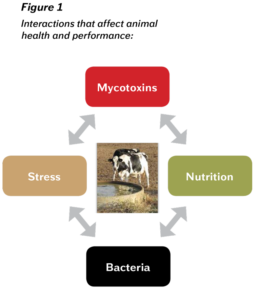Anti-Nutritional Trends And Thoughts With 2017 Feeds Across The Midwest
Click here to view as a pdf: Anti Nutritional Trends And Thoughts
By Dr. John Goeser, Phd, PAS & Dipl. ACAN-Rock River Laboratory, Inc.
Contributing Editor
Historically, mold, yeast and mycotoxins are thought of as the primary contaminants in feed that rob high performing dairy cattle of health and nutrition. More recently, stress and pathogenic bacteria have been better recognized as contributing factors that interact with fungal and mycotoxin contaminants. See Figure 1.

Feed hygiene and cleanliness has become a recognized topic on farms. The 2016 corn crop (silage and grain) brought considerable fungal and mycotoxin contamination, which subsequently challenged dairy cattle health and performance. Further, corn grain rumen digestibility trended downward (data not shown), which likely contributed to more grain bypassing the rumen into the lower digestive tract (small intestine and hind-gut). Mycotoxin impact, rumen bypass starch and pathogenic bacteria present on some farms materialized in a pathogenic “perfect storm” which lead to digestive upsets and eventual animal death in some cases; challenging dairy performance and profitability.
With the 2017 corn crop beginning to come off the fields, the desire is a cleaner crop. Professor Damon Smith, University of Wisconsin–Madison Plant Pathology Professor, and his research team are seeing less mold with this year’s crop. Confirming their observations, Rock River Laboratory’s team have also recognized downward trends in Vomitoxin and T-2 toxin concentration across all feeds as fall progresses. See Figures 2 and 3. Pathogenic bacteria, such as Clostridia perfringens, concentrations appear to be sporadic. See Figure 4.

In summary, the 2017 crop appears to be cleaner than that harvested in 2016 yet recent heavy rains coupled with cooler weather could create conditions where contaminants grow. Our focus should be optimal fermentation through aggressive management, which will help create a clean feed. Bacterial and fungal contaminants warrant consideration when nutrition, environmental or mycotoxin stress are present, contributing to immune suppression in cattle. Concern levels for contaminants are shown with red lines in Figures 2, 3 and 4. Feed and TMR fungal, bacterial and mycotoxin contamination measures and services, along with interpretation guidelines, are available online at Rock River Laboratory, Inc.: www.rockriverlab.com.
